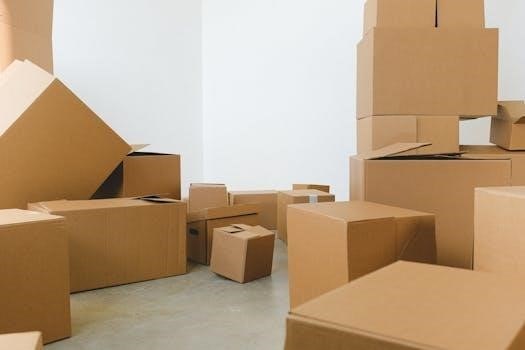moving into a new house checklist pdf
Summary
Stress-free move? Grab our moving house checklist PDF! It’s your secret weapon for a smooth transition. Download now and conquer moving!

Moving Checklist PDF⁚ Getting Started
Embarking on a move can feel overwhelming, but with a structured approach, it becomes manageable. A moving checklist PDF is your best tool for organizing your move. Start by downloading a comprehensive PDF, and begin your journey to your new home with confidence!
Creating a Moving Binder
Establishing a moving binder is a crucial initial step for a seamless relocation. This binder, whether physical or digital, will serve as your central hub for all things move-related. Include to-do lists, receipts, contracts, and any other important files. Organize this information logically, perhaps using dividers or folders for different categories. This way, you can easily track all tasks and important documentation. Consider adding a section for estimates from moving companies, a copy of your moving budget, and notes on any tax-deductible expenses. This organized approach will significantly reduce stress throughout the moving process, making it easier to find what you need when you need it.

Timeline for Moving Tasks
A well-structured timeline is crucial for a smooth move. Organize tasks by weeks leading up to moving day, focusing on packing, transportation, and essential items needed.
8 Weeks Before Moving⁚ Initial Planning
Eight weeks before your move, the focus is on initial planning. Begin by researching various moving services, including companies and rental options. Decide on a moving budget and create a moving binder to keep all receipts, contracts, and important documents organized. Start researching new banks, doctors, and schools in your new location if necessary. Also, research your rights on the US DOT and check the credibility of potential moving companies. It’s also a good time to make a list of questions to ask the moving companies and get estimates from at least three movers to compare. This early planning will lay a solid foundation for a less stressful move.
6 Weeks Before Moving⁚ Packing Focus
Six weeks before moving day, your primary focus should shift towards packing. This is the time to start gathering boxes, tape, and packing materials. You should begin packing non-essential items room by room to avoid feeling overwhelmed later on. As you pack, remember to keep a detailed inventory of what you’re boxing. Additionally, set aside a few days worth of clothing and important documents that you’ll need access to. Don’t forget to take time for friends and family before the moving day. This dedicated time for packing will make the final weeks of your move more manageable and organized.
2-3 Weeks Before Moving⁚ Packing and Essentials
With just two to three weeks remaining, intensify your packing efforts while focusing on essentials. By this stage, most non-essential items should be boxed. Begin packing items you use less frequently, but are still needed. Be sure to set aside a few days’ worth of clothing, toiletries, and other daily necessities. Keep important files and valuables separated for safe transport. This is also the time to start thinking about how you’ll move items like your television or computer equipment. A smooth move depends on having everything organized, labeled, and ready to go in these final weeks.

Moving Services and Logistics
Navigating moving services requires research and planning. From finding the right moving company to securing a suitable truck, logistics play a vital role in a smooth relocation.
Researching Moving Companies
Begin your moving journey by thoroughly researching moving companies. Seek recommendations from friends and family for reputable movers. Check the credibility of potential companies, ensuring they are licensed and insured. It’s crucial to understand your rights under the US Department of Transportation regulations. Make a list of essential questions to ask each moving company. Obtain quotes from at least three different companies to compare services and costs. Consider companies that offer international moving services if necessary. Look for movers with positive reviews and a proven track record. Remember, choosing the right moving company is key to a stress-free relocation process, so take your time and do your due diligence. Look for certified and insured professionals for a secure move.
Getting Moving Estimates
Securing accurate moving estimates is a vital step in your relocation. Obtain at least three quotes from different moving companies to ensure you get the best value. Be sure each estimate includes a detailed breakdown of all charges, including packing, loading, transportation, and any potential extra fees. Ask if the estimates are binding or non-binding, as this can significantly affect your final cost. Provide the movers with a thorough inventory of your belongings to receive a more precise quote. Compare the estimates carefully, not just focusing on the total price but also on the services included. Consider the reputation and reviews of the movers when evaluating the estimates. This thorough approach will help you avoid unexpected costs and make an informed decision.
Moving Truck Rental Options
Exploring moving truck rental options is crucial if you’re planning a DIY move. Research different rental companies to find the best fit for your needs and budget. Consider truck size based on the volume of your belongings, and factor in the distance you’ll be traveling. Compare prices, insurance options, and mileage rates from various providers. Check for any additional fees, such as equipment rental or drop-off charges. Book your truck well in advance, especially during peak moving seasons. Ensure the rental company offers roadside assistance and that the truck is in good working condition. Review the rental agreement carefully before signing to avoid any surprises. This thorough planning will help ensure a smooth and cost-effective moving experience.

Financial and Administrative Tasks
Moving involves crucial financial and administrative steps. Creating a budget, understanding tax deductions, and updating your address are key components. Stay organized with these essential tasks.
Creating a Moving Budget
Establishing a realistic moving budget is crucial for a stress-free relocation. Begin by listing all anticipated expenses, including moving company costs, packing supplies, truck rentals, and potential storage fees. Remember to factor in costs for new utility hookups, deposits, and any unforeseen expenses that may arise during the move. Research and compare prices for various services to ensure you get the best value. Be sure to include a buffer for unexpected costs. Tracking your spending throughout the moving process is essential for staying within budget. A well-planned budget will help you stay organized and avoid financial surprises during your move; This step is the foundation of a financially sound move.
Tax-Deductible Moving Expenses
Understanding which moving expenses are tax-deductible can significantly reduce your financial burden. According to the IRS, certain moving expenses are deductible if your move is closely related to the start of work at a new job location. These expenses can include the cost of transporting your household goods and personal items, as well as lodging during your move. Keep detailed records and receipts of all moving expenses, as you’ll need to provide documentation when filing your taxes. Be sure to consult a tax professional to verify eligibility. Familiarize yourself with the most recent IRS regulations on deductible moving expenses, as they can change. Proper documentation and knowledge of the rules will help you benefit from these tax deductions.
Change of Address Procedures
A crucial step in the moving process is updating your address with various institutions. Start by notifying the United States Postal Service (USPS) to forward your mail to your new location. This ensures you don’t miss any important correspondence. Additionally, inform banks, credit card companies, insurance providers, and healthcare professionals about your new address. Update your information with subscription services, magazines, and online retailers. Don’t forget to notify your employer and educational institutions if applicable. A change of address checklist can be helpful to keep track of all the necessary notifications. Timely updating your address will help you avoid any disruptions and maintain a seamless transition to your new home.

Packing and Organization
Efficient packing and organization are vital for a smooth move. Create a room-by-room inventory, pack essential items separately, and use clear labels for boxes. Careful planning simplifies unpacking.
Room-by-Room Inventory Checklist
Creating a room-by-room inventory checklist is a crucial step in your moving process. Start by walking through each room in your current home and meticulously noting down all items you plan to move. This comprehensive list will serve as a valuable reference during packing, loading, and unpacking. Include details such as the quantity, condition, and a brief description of each item. Utilizing this checklist helps prevent lost items, confirms that everything arrived at your new home, and aids in filing insurance claims should any damages occur during the move. A well-organized inventory is also extremely helpful when you are settling into your new place. It provides a roadmap for unpacking and helps you quickly locate what you need.
Packing Essential Items
Identifying and packing essential items separately is crucial for a smooth transition. These are the items you’ll need immediately upon arrival at your new home. Think about toiletries, medications, a change of clothes, phone chargers, and basic tools. Pack these in a clearly labeled box or suitcase that you will keep with you during the move. This prevents frantic searches through packed boxes when you need something urgently. Ensure you include any important documents, such as IDs, passports, and moving paperwork. Having these essentials readily available will make the first few days in your new place much more comfortable and less stressful. Remember to add a few snacks to get you through move-in day.
Using Moving Labels
Moving labels are invaluable for keeping your boxes organized and easily identifiable during the moving process. Use different colored labels for each room to help movers place boxes in the correct location. Clearly write the room name and a brief description of the contents on each label. This will save you time and frustration when unpacking, as you won’t have to open every box to find what you need. Consider using numbered labels and maintaining a corresponding inventory list. These can help with insurance claims if anything gets lost or damaged. Secure labels firmly to the boxes, ensuring they won’t fall off during transit. Remember, clear and consistent labeling will make your move much more efficient.
Post-Move Follow-Ups
After the move, focus on settling into your new home. Unpack essentials first, then organize room by room. Complete any change of address tasks and follow up with movers.
Settling into Your New Home
After the whirlwind of moving, it’s time to focus on settling in. Begin by unpacking essential items, such as toiletries, a change of clothes, and basic kitchen supplies. Take your time to organize each room, referring to your room-by-room inventory checklist to ensure all items are accounted for. Set up your bedroom to create a comfortable space to relax. Make sure to connect utilities and internet services. Explore your new neighborhood, locate local amenities and introduce yourself to your neighbors. This phase is about creating a comfortable and functional space, so be patient with yourself and enjoy the process of making your new house a home. Remember to complete any remaining change of address procedures.